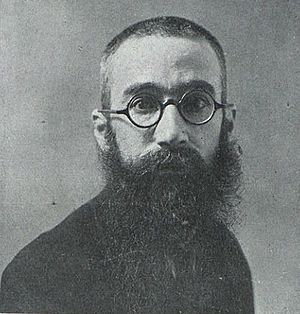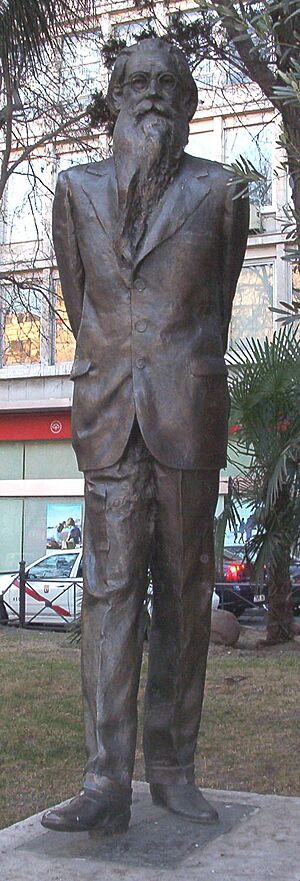Ramón del Valle-Inclán facts for kids
Quick facts for kids
Valle-Inclán
|
|
|---|---|

Valle-Inclán, photographed by Pau Audouard in 1911
|
|
| Born | Ramón María del Valle-Inclán 28 October 1866 Vilanova de Arousa, Pontevedra, Kingdom of Spain |
| Died | 5 January 1936 (aged 69) Santiago de Compostela, Second Spanish Republic |
| Occupation | Dramatist and novelist |
| Language | Spanish |
| Nationality | Spanish |
| Genres | |
| Literary movement |
|
| Spouse | Josefa María Ángela Blanco Tejerina |
| Children |
6
María de la Concepción (1908)
Joaquín María Baltasar (1914-1914) Carlos Luis Baltasar (1917-2006) María de la Encarnación Beatriz Baltasar Mariquiña (1919-2003) Jaime Baltasar Clemente (1922-1985) Ana María Antonia Baltasar (1924) |
Ramón María del Valle-Inclán y de la Peña (born October 28, 1866, in Vilanova de Arousa, Galicia, Spain – died January 5, 1936, in Santiago de Compostela) was a famous Spanish writer. He wrote plays, novels, and poetry. He was part of a group of Spanish writers known as the Generation of 98.
Valle-Inclán is known for being a very important and bold writer in the early 1900s. He changed how plays were written in Spain. His ideas also influenced many writers who came after him. Today, a statue of him in Madrid receives special honor from people in the theater world on national theater day.
Contents
Life Story of Valle-Inclán
Ramón María del Valle-Inclán was the second son of Ramón Valle-Inclán Bermúdez and Dolores de la Peña y Montenegro.
Early Life and Studies
As a child, he lived in Vilanova and A Pobra do Caramiñal. Later, he moved to Pontevedra to study high school. In 1888, he started studying law at the University of Santiago de Compostela. While there, he published his first story, Babel, in a magazine called Café con gotas.
He left his studies in 1890 and moved to Madrid. In Madrid, he wrote for several newspapers like El Globo and El Heraldo de Madrid.
Travels and First Book
In 1892, Valle-Inclán traveled to Mexico. He wrote for newspapers there, including El Universal.
He returned to Pontevedra in 1893. There, he wrote his first book, Femeninas (meaning Feminine), which was published in 1895.
Life in Madrid and Injury
In 1895, he moved back to Madrid. He worked for the Ministry of Public Instruction and Fine Arts. He also translated books by famous writers like Alexandre Dumas.
Even though he didn't have much money, he became well-known in Madrid's literary groups. These groups met in coffeehouses like Café Gijón. He was known for his unique style and looks, often dressing like a "dandy."
Valle-Inclán was known for his strong personality. In 1899, he got into an argument at a coffeehouse. During this fight, he was accidentally injured by another writer, Manuel Bueno. A cufflink from his shirt got stuck in his arm. This injury led to an infection, and sadly, Valle-Inclán had to have his arm removed.
In that same year, 1899, he met the famous writer Rubén Darío, and they became good friends. Around this time, he published his first play, Cenizas (meaning Ashes). This marked the beginning of a very busy writing period for him.
Family and More Travels
In 1907, he married the actress Josefina Blanco Tejerina.
In 1910, he traveled for six months with his wife on her acting tour. They visited many countries in Latin America, including Argentina, Chile, and Uruguay.
He returned to Galicia in 1913 and lived in Cambados. After his second son passed away, he moved to A Pobra do Caramiñal.
In 1916, he published a poem in the Galician language called Cantiga de vellas (meaning Song of old women). This poem is very important to Galician literature.
War and Politics
During World War I, Valle-Inclán supported the Allied forces. He even visited the war front several times as a reporter for a newspaper called El Imparcial.
In 1921, he traveled to México again. The President of Mexico, Álvaro Obregón, invited him. He took part in many cultural events and was very impressed by the Mexican Revolution. On his way back to Spain, he stopped in Havana and New York City. In 1921, he was also chosen to be the President of the International Federation of Latin American Intellectuals.
He returned to Spain at the end of 1921 and began writing his novel Tirano Banderas (meaning Tyrant Banderas). He moved back to Madrid in 1922, still inspired by the spirit of the Mexican Revolution.
From 1924 onwards, he openly spoke against the government of Miguel Primo de Rivera, which was a dictatorship.
When the Second Spanish Republic began, he tried to become a politician. He ran in elections but did not win a seat.
Later Life and Death
In 1932, he divorced his wife. He was appointed Director of the Museum of Aranjuez and President of the Ateneo of Madrid, which was a cultural center. The government also made him in charge of Spain's national art treasures. However, he often disagreed with the government about the poor condition of palaces and museums. These disagreements led him to resign from his position.
In 1933, he became the director of the Spanish Academy of Fine Arts in Rome, Italy.
Ramón María del Valle-Inclán passed away in Santiago de Compostela, Galicia, Spain, on January 5, 1936.
His Works and Style
Valle-Inclán's early writings were influenced by French symbolism and modernism. These styles focused on using symbols and new ways of expression. However, his later works became more experimental and radical. He did not like "literary realism," which tried to show life exactly as it was.
His political ideas also changed over time. He moved from supporting traditional absolute rule (known as Carlismo in Spain) to supporting anarchism, which is a belief in no government. These changing views sometimes caused him problems.
Valle-Inclán always tried to live by his "bohemian ideals," which meant living an unconventional, artistic life. He also stayed true to his "aestheticist" beliefs, focusing on beauty in art. Even so, he sometimes had to write popular novels in secret to earn money.
Challenging Traditional Theater
Works by Valle-Inclán, such as Divine Words (Divinas palabras) and Bohemian Lights (Luces de Bohemia), criticized what he saw as the "hypocrisy" (pretending to be better than you are) and "moralizing" (telling others what's right or wrong) of other playwrights. He used "satire" (making fun of something to show its flaws) to criticize the ruling classes.
He also targeted ideas like "masculine honor," "militarism" (strong military focus), "patriotism" (love for one's country), and being too obedient to the King and the Roman Catholic Church. His plays often showed important figures from Spain's past in a disrespectful way. He used strong, sometimes rude, language and images to attack boring theater.
Valle-Inclán's plays were not only politically challenging but also hard to stage. They often needed complex special effects and quick changes of scenery. Because of this, some of his works are called "closet dramas." This means they were often read more than they were performed on stage.
Novels and Influence
Valle-Inclán also wrote important novels. One famous novel is Tyrant Banderas (Tirano Banderas). This book was very influential for "dictator novels" in Latin America. These are stories about powerful, often cruel, leaders.
Some people compare Valle-Inclán to the famous Irish writer James Joyce. However, because not many of his works have been translated into English, he is not as well-known in English-speaking countries. But his reputation is slowly growing as more translations are made.
Plays
- Cenizas. Drama en tres actos (1899)
- El marqués de Bradomín. Coloquios románticos (1907)
- Águila de blasón. Comedia bárbara (1907)
- Romance de lobos. Comedia bárbara (1908)
- El yermo de las almas (1908)
- Farsa infantil de la cabeza del dragón (1909)
- Cuento de abril. Escenas rimadas en una manera extravagante (1910)
- Farsa y licencia de la Reina Castiza (1910)
- Voces de gesta. Tragedia pastoril (1911)
- El embrujado. Tragedia de tierras de Salnés (1913).
- La marquesa Rosalinda. Farsa sentimental y grotesca (1913)
- Divine Words-Divinas palabras. Tragicomedia de aldea (1919)
- Farsa italiana de la enamorada del rey (1920)
- Farsa y licencia de la Reina Castiza (2nd edition, 1920)
- Bohemian Lights-Luces de bohemia. Esperpento (1920) (12 scenes)
- Silver Face Cara de Plata. Comedia bárbara (1922)
- ¿Para cuándo son las reclamaciones diplomáticas? (1922)
- Bohemian Lights-Luces de bohemia. Esperpento (2nd edition, enhanced, 1924) (15 scenes)
- La rosa de papel. Novela macabra (1924)
- La cabeza del Bautista. Novela macabra (1924)
- Los cuernos de don Friolera. Esperpento (1925)
- Tablado de marionetas para educación de príncipes (1926). Contains: Farsa y licencia de la Reina Castiza, Farsa italiana de la enamorada del rey, Farsa infantil de la cabeza del dragón
- El terno del difunto (1926) (renamed as Las galas del difunto in 1930)
- Ligazón. Auto para siluetas (1926)
- La hija del capitán. Esperpento (1927)
- Sacrilegio. Auto para siluetas (1927)
- Retablo de la avaricia, la lujuria y la muerte (1927). Contains: Ligazón. Auto para siluetas, La rosa de papel, La cabeza del Bautista, El embrujado, Sacrilegio. Auto para siluetas
- Martes de Carnaval. Esperpentos (1930). Contains: Las galas del difunto (El terno del difunto), Los cuernos de don Friolera. Esperpento, La hija del capitán. Esperpento
Prose
- The Pleasant Memoirs of the Marquis de Bradomín – Sonatas: Memorias del Marqués de Bradomín
- Spring and Summer Sonatas – Sonata de primavera y Sonata de estío (1904 and 1903)
- Autumn and Winter Sonatas – Sonata de otoño y Sonata de invierno (1902 and 1905)
- Flor de santidad (1904)
- La pipa de kif (lyric poem) (1919)
- Tyrant Banderas – Tirano Banderas (1926)
- The Lamp of Marvels
Film Adaptations
Many of Valle-Inclán's works have been turned into movies:
- 1948: L'Amore (partly based on Flor de santidad)
- 1959: Sonatas (based on Sonatas: Memorias del Marqués de Bradomín)
- 1973: Flor de santidad
- 1976: Beatriz (based on Beatriz y Mi hermana Antonia)
- 1977: Divinas palabras
- 1985: Luces de bohemia
- 1987: Divinas palabras
- 1993: Banderas, the Tyrant
See also
 In Spanish: Ramón María del Valle-Inclán para niños
In Spanish: Ramón María del Valle-Inclán para niños
- Café Gijón (Madrid)
- Esperpento
- Plaza de las Cinco Calles


